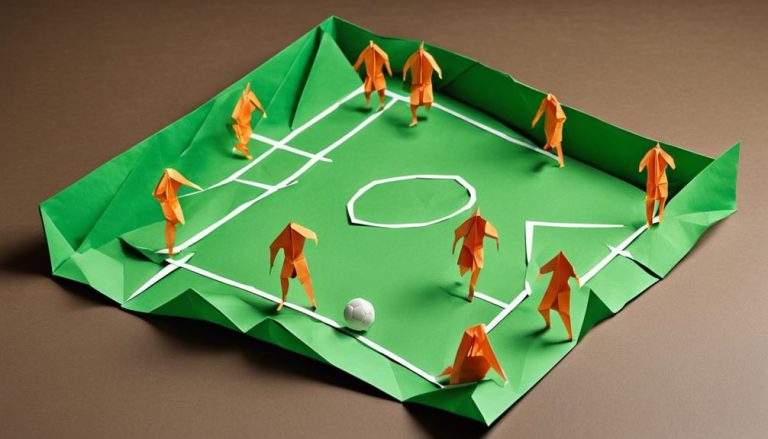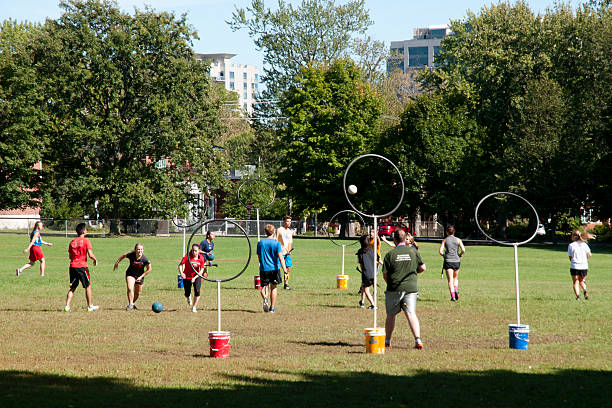General Rules of Rink Bandy
Did you know that rink bandy has specific rules that govern the game? From equipment requirements to scoring systems, there are various aspects to ponder when playing this exciting sport. Understanding the regulations surrounding game duration, offside rules, and penalties is vital for players and spectators alike. Stay tuned to discover the intricacies of rink bandy's general rules and how they shape the gameplay experience.
Equipment Requirements
When gearing up for a game of Rink Bandy, it's critical to make sure that you have the proper equipment to play safely and effectively. Safety gear is a top priority in Rink Bandy to protect players from potential injuries. Make sure to wear a helmet that fits securely and provides adequate head protection. Additionally, wearing elbow pads, knee pads, and gloves is essential to prevent injuries during intense gameplay. These safety precautions are vital to ensure that you can enjoy the game without unnecessary risks to your well-being.
Stick regulations are another vital aspect to consider when preparing for a game of Rink Bandy. The stick you use must comply with the regulations set forth in the sport to maintain fairness and safety on the rink. The stick's length should be appropriate for your height, allowing you to play effectively without compromising your performance. It's important to familiarize yourself with the rules regarding stick dimensions to avoid penalties during gameplay.
Game Duration and Periods
Ensuring a structured and organized gameplay experience, Rink Bandy follows specific guidelines regarding game duration and periods to maintain fairness and competitiveness on the rink. Understanding these rules is important for mastering the game and leading your team to victory. Here are some key points to keep in mind:
- Game Duration: Rink Bandy matches typically consist of two halves, each lasting 30 minutes, resulting in a total game time of 60 minutes. This duration allows for strategic gameplay and ample opportunities to showcase your skills on the ice.
- Intermission: A brief 10-minute intermission separates the two halves, giving players a chance to regroup, hydrate, and discuss game strategy with their coaches. Effective use of this time can make a significant difference in your team's performance.
- Overtime: In the event of a tie at the end of regulation time, teams may face an overtime period of 10 minutes. This sudden-death period adds an extra layer of excitement and pressure, requiring quick thinking and precise execution.
- Time Management: Efficient time management is key in Rink Bandy. Coaches must carefully consider line changes, ensuring players are strategically positioned on the rink to maximize scoring opportunities and defensive capabilities. Stay alert and adapt quickly to keep your opponents on their toes.
Scoring System
When it comes to scoring in rink bandy, understanding the point system is essential. Points are awarded based on goal values, penalty shot rules, and overtime scoring rules. Familiarizing yourself with these scoring aspects will enhance your gameplay and strategic decisions on the rink.
Goal Values Explained
Explaining the scoring system in rink bandy involves understanding the specific values assigned to different types of goals. Here's a breakdown to help you grasp the goal values in this exciting sport:
- Regular Goal: A goal scored during regular play earns your team 1 point.
- Power Play Goal: When a team scores during a power play (due to a penalty), they receive 2 points.
- Penalty Shot Goal: Successfully converting a penalty shot results in 3 points.
- Empty Net Goal: Scoring on an empty net, when the opposing team has pulled their goalie, is worth 4 points.
Understanding these values can help you strategize your offensive plays effectively to maximize your team's scoring potential.
Penalty Shot Rules
To further understand the scoring system in rink bandy, let's now focus on the Penalty Shot Rules. Penalty shots are awarded when a player is fouled on a clear scoring opportunity. During a penalty shot, the shooter must start from the center circle and has a one-on-one chance against the goalie. Shooter positioning plays a vital role as they aim to outsmart the goalie with their shot. Goalies, on the other hand, employ various tactics to anticipate the shooter's move and make a save. Goalie interference is strictly prohibited during a penalty shot, and if it occurs, a video review may be used to determine the validity of the goal. Understanding these rules enhances the excitement and fairness of penalty shots in rink bandy.
Overtime Scoring Rules
In overtime, teams in rink bandy endeavor to secure victory by utilizing strategic scoring rules that differ from regulation play. When the game is tied at the end of regular time, the intensity ramps up as both teams aim to clinch the win. Here are some key factors to know about overtime scoring rules:
- Sudden Death: The first team to score in overtime wins the game immediately.
- Shootout: If neither team scores during the sudden death period, a shootout may occur.
- Tiebreaker: Shootouts consist of a series of tiebreaking shots by selected players from each team.
- Golden Goal: The team that scores first during the shootout wins, also known as the golden goal.
These rules add an exciting twist to the game, keeping fans on the edge of their seats until the very end.
Playing Area Dimensions
When it comes to playing rink bandy, understanding the points related to the playing area dimensions is important. You need to be aware of the rink bandy field size, the specific measurements of the boundary lines, and the correct placement of the goal posts. These points directly impact the dynamics of the game and play a significant role in how the match unfolds.
Rink Bandy Field Size
Amidst the strategic gameplay of Rink Bandy, understanding the dimensions of the playing area is important for players and spectators alike. Here's what you need to know about the field size in Rink Bandy:
- Field Dimensions: The standard rink size for Rink Bandy is 40 meters in length and 20 meters in width.
- Player Positions: Each team typically consists of six players – five outfield players and one goalkeeper.
- Strategic Considerations: The field dimensions impact gameplay tactics, requiring players to adapt their strategies accordingly.
- Spectator Experience: A compact playing area guarantees an engaging and fast-paced viewing experience, keeping spectators on the edge of their seats.
Understanding the field size is fundamental to mastering the game and enjoying the thrill of Rink Bandy.
Boundary Line Measurements
The boundary lines in Rink Bandy delineate the dimensions of the playing area with precision and strategic significance. Line marking is vital in defining the boundaries where the game unfolds. Boundary measurements guarantee a standardized playing area, maintaining fairness and consistency in gameplay. Here is a breakdown of the typical measurements for a Rink Bandy playing area:
| Boundary | Measurements |
|---|---|
| Length | 40-50 meters |
| Width | 20-30 meters |
| Corner Radius | 3 meters |
| Center Circle Diameter | 3-4 meters |
Accurate line marking and adherence to boundary measurements are essential for players to navigate the rink effectively and showcase their skills. Understanding these dimensions enhances the overall experience of playing Rink Bandy.
Goal Post Placement
Continuing from the focus on the boundary lines in Rink Bandy, the placement of the goal posts within the playing area is a critical aspect that impacts the dynamics of the game. When setting up the goal posts, consider the following:
- Goalie Positioning: Proper goal post placement can affect where the goalie positions themselves, influencing their ability to defend the goal effectively.
- Defensive Strategies: The distance between the goal posts can determine defensive strategies, such as how players position themselves to block shots or intercept passes.
- Goal Post Maintenance: Regular checks and maintenance of the goal posts are necessary to make sure they are stable and in good condition.
- Safety Precautions: Securing the goal posts properly reduces the risk of injury to players and ensures a safer playing environment.
Attention to goal post placement is crucial for a smooth and strategic game of Rink Bandy.
Face-Offs and Restarts
When preparing to engage in face-offs and restarts in rink bandy, players must adhere to specific rules and procedures to guarantee fair play and proper execution. Face-offs are important moments in a rink bandy game where play restarts after stoppages. Proper face-off techniques and player positioning are essential for gaining an advantage. Players must be ready to compete for the ball by using quick reflexes and strategic positioning to control the outcome of the face-off.
Restart strategies play a significant role in maintaining momentum and controlling the pace of the game. Quick shifts from defense to offense or vice versa are key to catching the opposing team off guard. Players need to be prepared to react swiftly and decisively during restarts to capitalize on scoring opportunities or prevent the opposition from gaining an advantage.
Understanding the intricacies of face-offs and restarts can give your team an edge on the rink. By mastering the techniques and strategies involved, you can effectively dictate the flow of the game and outmaneuver your opponents. Stay focused, be prepared, and seize every opportunity that comes your way during face-offs and restarts to elevate your rink bandy performance.
Offside and Icing Rules
Understanding offside and icing rules in rink bandy is essential for players to navigate the game strategically and avoid penalties. These rules are vital for maintaining fair play and ensuring an exciting and competitive match. Let's explore deeper into the tactics and strategies surrounding offside and icing in rink bandy:
- Offside Tactics: Mastering offside tactics involves timing your movements precisely to stay onside and create scoring opportunities without breaking the rules.
- Icing Strategies: Icing can be a valuable strategic move when used effectively to relieve pressure or set up a play, but it can also result in turnovers if not executed correctly.
- Offside Variations: Understanding the different variations of offside calls, such as delayed offside or intentional offside, can give your team a tactical advantage and help you avoid unnecessary stoppages.
- Icing Scenarios: Being prepared for various icing scenarios, like defensive icing to defend a lead or offensive icing to press the opponent, can give your team the edge in critical moments of the game.
Penalties and Suspensions
As you navigate the intricacies of offside and icing rules in rink bandy, it is important to be aware of the repercussions that penalties and suspensions can have on your team's performance and dynamics. Player behavior is a critical aspect of any sport, and rink bandy is no exception. When players engage in misconduct such as tripping, slashing, or unsportsmanlike conduct, disciplinary measures like penalties and suspensions come into play.
Penalties in rink bandy can have a big impact on the flow of the game and team strategies. When a player receives a penalty, their team is forced to play with one less player on the ice. This creates a power play opportunity for the opposing team, giving them an advantage in terms of numbers. Teams must adapt their strategies during penalty kills, focusing on defensive play and quick shifts to minimize the chances of the opposing team scoring.
Suspensions, which are more severe than penalties, can have long-term effects on a team. Losing a key player to suspension not only affects the team's performance on the ice but can also disrupt team dynamics and morale. It is essential for players to maintain composure, adhere to the rules, and understand the impact their behavior can have on themselves and their team.
Referee Signals and Communication
Traversing the fast-paced game of rink bandy requires a keen understanding of the various referee signals and effective communication on the ice. Referees play an important role in maintaining order and ensuring fair play, not only through their decisions but also through their signals and communication style. Here's a breakdown of essential aspects of referee signals and communication in rink bandy:
- Referee Positioning: Referees strategically position themselves on the ice to have a clear view of the game. By being in the right spots, they can effectively monitor player actions and detect any infractions promptly.
- Hand Signals: Referees use specific hand signals to communicate decisions to players, coaches, and spectators. These signals are standardized across rink bandy to ensure clarity and understanding of the calls made during the game.
- Communication with Players: Effective communication between referees and players is important for the smooth running of the game. Referees must be able to explain their decisions clearly to players to avoid confusion or disputes on the ice.
- Communication with Coaches: Referees also engage in communication with coaches, providing necessary information and addressing any concerns raised from the bench. This dialogue helps in maintaining a respectful environment and resolving potential conflicts swiftly.
Frequently Asked Questions
Are There Any Restrictions on the Type of Footwear Players Can Wear During a Rink Bandy Game?
During a rink bandy game, players are free to choose their footwear, but it must adhere to safety standards. No restrictions on types of footwear exist, allowing players to wear what they find most comfortable and suitable.
Can Players Use Their Hands to Stop the Ball or Are They Only Allowed to Use Their Sticks?
You're only permitted to use your stick for ball control in rink bandy, providing strategic advantages in gameplay. While hand use isn't allowed, mastering stick skills becomes pivotal for effective play and scoring goals.
Are There Any Specific Rules Regarding the Size or Material of the Ball Used in Rink Bandy?
Imagine a ball, not too big, not too small, just the right size for fast-paced play. In rink bandy, the ball must be made of rubber and meet specific weight requirements, ensuring fair and consistent gameplay.
How Are Tiebreaker Situations Handled in Rink Bandy Games?
In rink bandy, tiebreaker situations are resolved through overtime rules. If the tie persists, a shootout format may be used. Referees have discretion to guarantee fair play and apply the rules as needed.
Is There a Specific Minimum or Maximum Number of Players Required to Start a Rink Bandy Game?
So, you're itching to hit the rink for some bandy action, huh? Well, to get the party started, you just need a minimum of 5 players. But hey, don't go overboard – max is 11!






